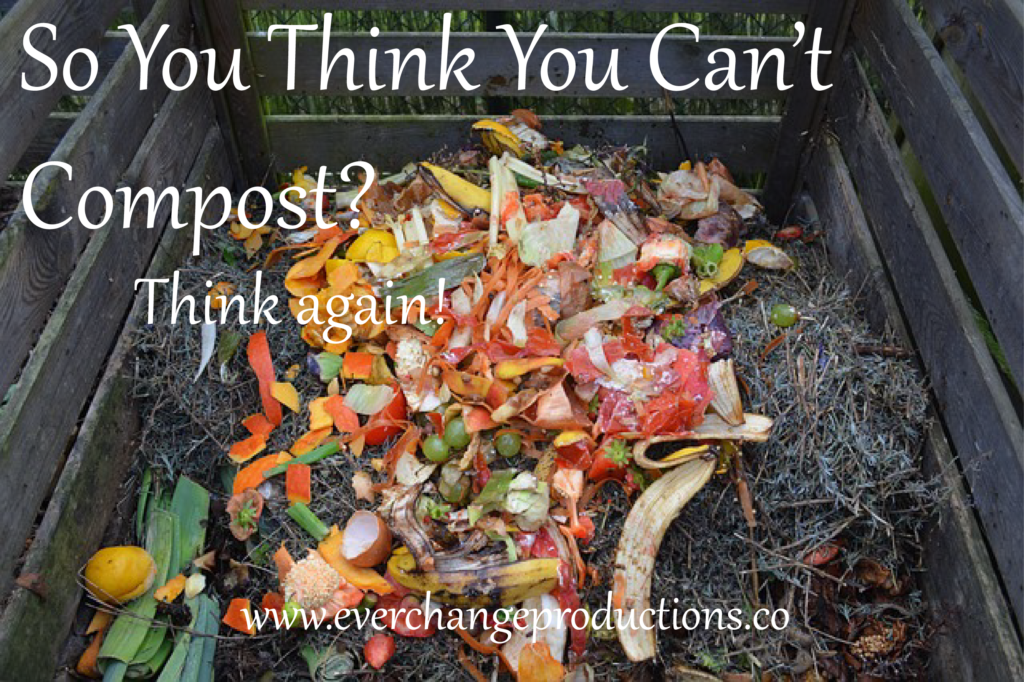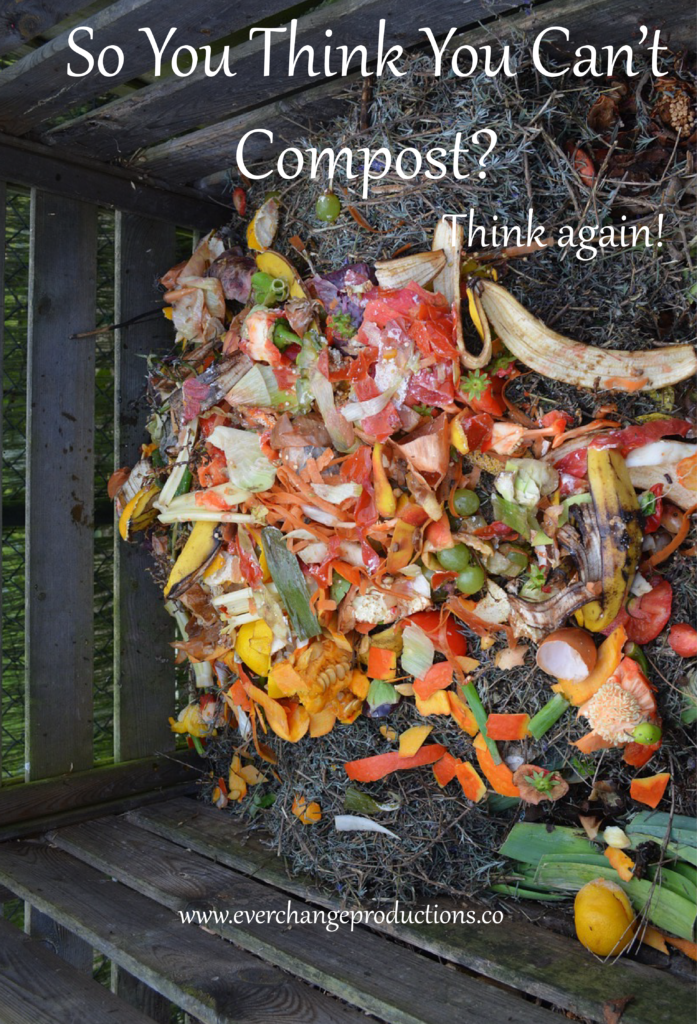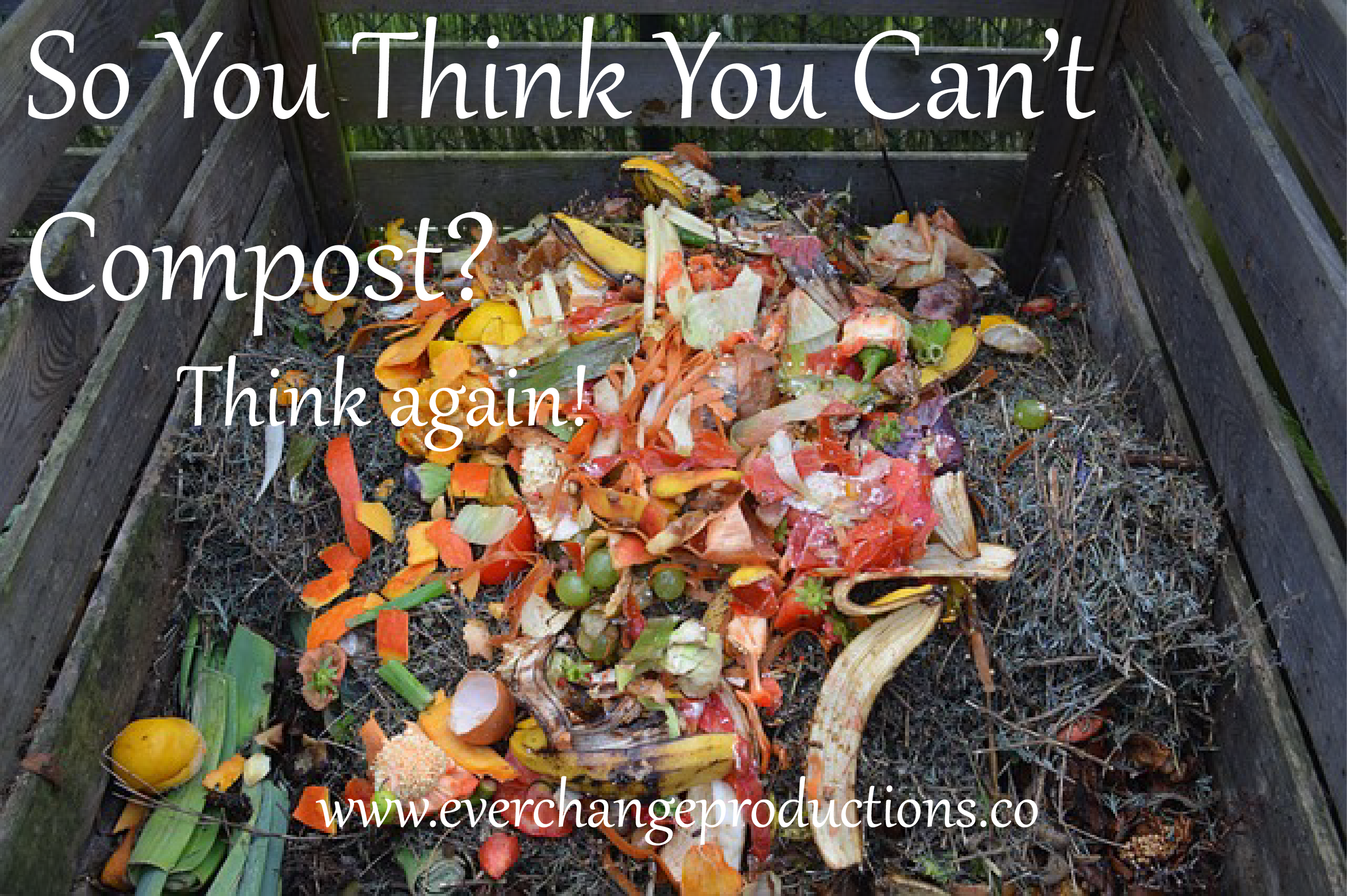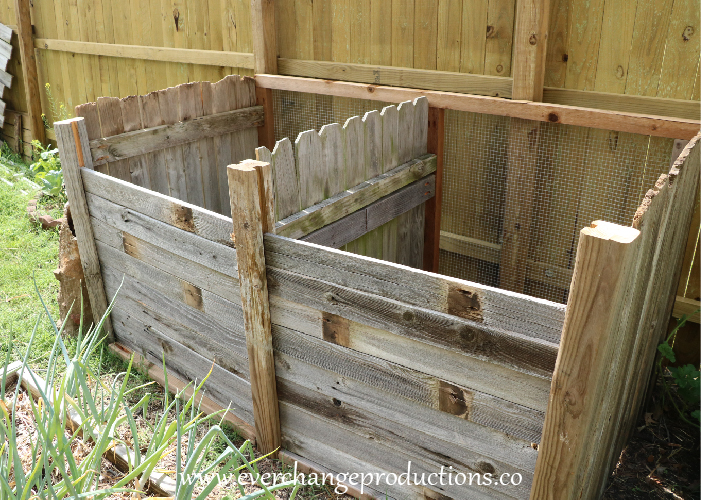So You Think You Can’t Compost?
With these home composting system options, you can compost anywhere, even in small spaces!

This post has affiliate links.
Compost Definition
Compost is decayed organic material used as a plant fertilizer.
It’s the decomposition of plant remains and other once-living materials to make an earthy, dark, crumbly substance that enriching garden soil. It is the way to recycle your yard and kitchen wastes, and is a critical step in reducing the volume of garbage needlessly sent to landfills for disposal.
Composting Process
The beauty of composting is ANYONE can do it. Unlike other recycling opportunities, there is no infrastructure required, so any city, any organization, any individual has the ability and the space to compost.
Composting is not a modern invention. In the natural world, composting is what happens as leaves pile up on the forest floor and begin to decay. Eventually, the rotting leaves are returned to the soil, where living roots can finish the recycling process by reclaiming the nutrients from the decomposed leaves.
Composting may be at the root of agriculture as well. Some scientists have speculated that as early peoples dumped food wastes in piles near their camps, the wastes rotted and were terrific habitat for the seeds of any food plants that sprouted there. Perhaps people began to recognize that dump heaps were good places for food crops to grow, and began to put seeds there intentionally.
Benefits of Composting
Yard and kitchen waste make up about 30% of the waste stream. Most of it from the kitchen was probably stuff that was bought and then wasted because it was never eaten. And that’s why composting is so beneficial. It takes that waste and creates something that is useful again. It’s the food version of recycling and it’s organic!
Compost benefits the soil in several ways that synthetic fertilizers don’t. First, it adds organic matter, which improves the way water interacts with the soil. In sandy soils, compost acts as a sponge to help retain water in the soil that would otherwise drain down below the reach of plant roots (in this way, it protects plants against drought). In clay soils, compost helps to add porosity (tiny holes and passageways) to the soil, making it drain more quickly so that it doesn’t stay waterlogged or dry into a hard substance. Compost also inoculates the soil with vast numbers of beneficial microbes (bacteria, fungi, etc.) and the habitat that the microbes need to live. These microbes are able to extract nutrients from the mineral part of the soil and eventually pass the nutrients on to plants.
Composting at Home
There are so many home composting system options, whether you have a lot of room, hardly any room, a yard, no yard, building skills or just eating skills, there is a composting system out there that will work for you.
Some people choose to go binless, simply building a compost pile in a convenient spot on the ground. Others build bins from materials such as recycled pallets, or two-by-fours and plywood. And, of course, there are many commercial bins on the market.
Composting in Apartments
If you’re like me and you live in an apartment, this vermicomposting system is definitely the way to go. I made mine from cat litter boxes, but you can find similar containers on Craigslist for like $1. Similar set-ups called worm factories are sold online for close $100, so this is such a great idea that lets you save money and reuse materials. I’ve had mine for about 6 months and it’s doing great so far. If you’re interested in learning about vermicomposting, check out this 2-part video series and learn how to set-up a worm bin, start to finish.
If worms just aren’t for you, check out these other apartment composting options.
Interested in composting, but don’t know where to start? Subscribe for access to a free quiz and find the best composting option for you.
Building Your Own Composter
If you decide to make a compost bin outside, avoid treated lumber. It contains arsenic, a highly toxic element (it also contains toxic levels of copper and chromium). There is evidence to suggest that arsenic will leach into your compost.
The question arises, “Which system is best?” Each system has advantages and disadvantages that you should consider when making your choice. There are some very attractive and well-engineered commercial bins out there, as well as plans for excellent do-it-yourself compost bins. But why not find out about all the options?
Home Composting System Options
One Bin Compost Systems:
Backyard composting systems are a great way to reduce waste while also making healthy soil for your garden. A one bin system is the simplest way to make a compost pile, and is a great way to get started. If you plan to make a lot of compost, one bin may not be enough capacity, but adding another is simple. The basic idea of a one bin system is to make an enclosure for your bin that is at least three feet across. Possible construction materials include free wooden pallets from local businesses, lumber, cinder blocks, or even steel posts and wire fencing. Once you’ve made your bin, you might build a pile all at once if you have the ingredients, but it’s more likely you’ll build the pile over time.
If you build the pile over time, the stuff on the bottom will decompose first, since it will have been there the longest. When there is finished compost at the bottom of the bin, and you want to use it, simply remove the unfinished compost from on top, take out what you need, and throw the unfinished compost back on top.
Two Bin and Three Bin Compost Systems:
These systems consist of two or three adjacent bins, and may be made out of the same materials as a one bin system. The advantage of having more than one bin is that one can have a bin for the pile being built (as ingredients are accumulated over a period of time) and another one (or more) for a pile already built that is in a more advanced stage of decomposition. If you have the space for such a system, and are generating or gathering enough materials to keep the bins in use, this can be very convenient.
Check out this step by step tutorial for building your own composter.
Rotating or Tumbling compost systems are another home composting system options for the backyard composter. However, the cost of rotating or tumbling systems can be quite high, usually starting around $100, and they are somewhat small, around 37 gallons, but bigger and more expensive one can be found. These factors are balanced out by the speed at which drum/tumbler systems can generate finished compost. Under ideal circumstances, compost may be finished in three weeks in a rotating drum composter. Fill the container partly full with a mix of greens and moistened browns, and then give the unit a turn every day or so to aerate the ingredients and remix them. It’s important not to pack the container full, because the ingredients won’t tumble and mix if packed in tightly.
While one batch is composting, you can accumulate the materials for the next batch. When the first compost is finished, you can dump in the materials you’ve saved to make more. It’s possible to maintain relatively high temperatures in drum/tumbler systems even if they are small, both because the container acts as insulation and because the constant turning keeps the microbes aerated and active.
Sheet or Trench Composting:
This may be the ideal home composting system for people that have garden space who don’t want to fuss with bins and piles. Simply bury your kitchen wastes in a trench 8″ deep dug in the garden, leave the buried materials to rot for a few months, and then plant above them. By the time you plant, the materials will have rotted into stuff in which plant roots will thrive. If you have copious amounts of materials to get rid of all at once, such as autumn leaves, you might want to spread them around the garden and rototill them into the soil (this is best done in the late autumn, or at least 2 months in advance of planting in the area).
Commercially Available Bin Systems:
Commercially available bins are typically somewhat expensive compared to a do-it-yourself home composting system, but they do keep your compost neatly enclosed and can provide an ‘instant solution’ to the question of how to set up a composting system. In performance, many of the plastic bins may help to insulate the compost somewhat, allowing decomposition to occur later into the cold season. However, I don’t feel that there are major advantages in the actual composting performance of commercial bins — they function more or less the same as a one bin system.
Many of the companies sell plastic bins manufacture them from recycled plastic. If you plan to get a pre-built plastic bin, keep your eyes open for ones made from reclaimed plastic — support recycling and businesses that sell recycled products!
The Compost Process: How do you make a good compost pile?
A successful home composting system is a matter of providing the proper environmental conditions for microbial life. Compost is made by billions of microbes (fungi, bacteria, etc.) that digest the food you provide for them. If the pile is cool enough, worms, insects, and their relatives will help out the microbes. However, like people, these living things need air, water, and food. If you maintain your pile to provide for their needs, they’ll happily turn your yard and kitchen wastes into compost.
Keep in mind the following basic ideas while building your compost piles:
AIR
Composting microbes are aerobic — they can’t do their work well unless they are provided with air. Without air, anaerobic (non-air needing) microbes take over the pile. They do cause slow decomposition, but tend to smell like putrefying garbage. To avoid this, make sure there are plenty of air passage ways into your compost pile, use a mixture of ingredients that get slimy and mat down the pile such as grass or wet leaves and ones that don’t like straw which will help the pile breathe better. Turning, completely breaking apart the mixture with a spade or another gardening utensil and then putting it back together, is also a good way to add air to your pile.
WATER
Ideally, your pile should be as moist as a wrung-out sponge to fit the needs of compost microbes. At this moisture level, there is a thin film of water coating every particle in the pile, making it very easy for microbes to live and disperse themselves throughout the pile. If your pile is drier than this, it won’t be very good microbial habitat, and composting will be slowed significantly. If your pile is a great deal wetter, the sodden ingredients will be so heavy that they will tend to mat down and exclude air from the pile, again slowing the composting process (and perhaps creating anaerobic odor problems). If you are using dry ingredients, such as autumn leaves or straw, you’ll need to moisten them as you add them to the pile. Kitchen fruit and vegetable wastes generally have plenty of moisture, as do fresh green grass clippings and garden thinnings. Watch out for far-too-soggy piles in wet climates (a tarp may help to keep rain off during wet weather). In dry climates, it may be necessary to water your pile occasionally to maintain proper moisture.
FOOD
In broad terms, there are two major kinds of food that composting microbes need.
There are hundreds of options of composting materials. They are broken up into two major categories.
‘Browns’ also known as carbons are dry and dead plant materials such as straw, dry brown weeds, autumn leaves, and wood chips or sawdust. These materials are mostly made of chemicals that are just long chains of sugar molecules linked together. As such, these items are a source of energy for the compost microbes. Because they tend to be dry, browns often need to be moistened before they are put into a compost system.
‘Greens’ (nitrogens) are fresh (and often green) plant materials such as green weeds from the garden, kitchen fruit and vegetable scraps, green leaves, coffee grounds and tea bags, fresh horse manure, etc. Compared to browns, greens have more nitrogen in them. Nitrogen is a critical element in amino acids and proteins, and can be thought of as a protein source for the billions of multiplying microbes.
A good mix of browns and greens is the best nutritional balance for the microbes. This mix also helps out with the aeration and amount of water in the pile. Browns, for instance, tend to be bulky and promote good aeration. Greens, on the other hand, are typically high in moisture, and balance out the dry nature of the browns.
OTHER THINGS TO CONSIDER
If you live in a cold climate, your compost pile will probably go dormant in the winter. No problem — it’ll start back up again when the springtime thaw comes.
A common misunderstanding about compost piles is that they must be hot to be successful. This just isn’t true. If you have good aeration and moisture, and the proper ingredient mix, your pile will decompose just fine at temperatures of 50 degrees Farenheit or above. Hotter piles will decompose faster because it gives the microbes faster metabolisms.
For a pile to get hot and stay hot for a long period of time, the typical minimum size for the pile is one cubic meter (a cube one meter, or about three feet, on a side). A pile this size has plenty of mass in which those billions of heat-generating microbes can live, yet is also large enough that the center of the pile is well-insulated by the material surrounding it. Smaller piles just cannot insulate themselves well enough to remain hot for long, if at all. You can also provide additional insulation to a pile by stacking bales of hay or straw, or bags of dry autumn leaves, around your bin system.
There is no single point at which the compost is finished. What you’re looking for is for it be dark in color and has an earthy smell (like the smell of soil). Usually, it’s difficult to recognize any of the original ingredients, though bits of hard-to-decompose materials (such as straw) sometimes can be seen. If you plan to use compost in seed-starting mixes, though, you’re best off having a well-finished compost, because seedling roots may be attacked by decomposer microbes if the roots contact unfinished compost.
What not to put in your compost?
To make sure that you’re your home composting system is safe here are some things to avoid:
Chemically-treated wood products or sawdust from those products. For example, take pressure-treated wood (sometimes called CCA), which usually has a greenish, and sometimes other colors, tint to it. It contains arsenic, a highly toxic element, as well as chromium and copper. There is evidence to suggest that arsenic is leached into the soil from these products when they are used to make compost bins or raised beds, so composting the sawdust would certainly be a mistake. Avoid other chemically-treated wood products and sawdust as well, such as wood treated with creosote or ‘penta’ preservative.
Diseased plants. Many plant disease organisms are killed by consistent hot composting, but it’s difficult to make sure that every speck of the diseased material gets fully composted. It’s best not to compost diseased plant material at all, to avoid reinfecting next year’s garden.
Human feces. It can contain disease organisms that will make people very sick. Composting human feces safely requires that the compost pile reach high (thermophilic) temperatures over a period of time. It isn’t necessarily that difficult to reach these temperatures in a home compost pile, but the potential health costs of improper composting are high. Composting of human feces should not be attempted, except by experienced ‘hot pile’ composters who are well informed of the temperatures and times required to kill pathogens, and who are willing to take 100% responsibility for the process and product.
Meat, bones and fatty food wastes. These materials are very attractive to pests (in an urban setting, this could mean rats…). In addition, fatty food wastes can be very slow to break down, because the fat can exclude the air that composting microbes need to do their work.
Weeds. Morning glory/bindweed, sheep sorrel, ivy, several kinds of grasses, and some other plants can resprout from their roots and/or stems in the compost pile. Just when you thought you had them all chopped up, you’d actually helped them to multiply. Don’t compost these weeds unless they are completely dead and dry (you may want to leave them in a sunny place for a couple of weeks before composting). Remember also that composting weeds that have gone to seed will create weeds in next year’s garden, unless a very hot pile temperature can be maintained to kill the seeds.
Pet wastes. Dog and cat feces may carry diseases that can infect humans. It is best NEVER to use them in compost piles. Some people do bury them 8″ deep in the soil, but ONLY in areas where food crops are never grown.
If you are trying to compost already, but it doesn’t seem quite right, check out these troubleshooting tips.
Need this information later? Pin here!



I pile all the Autumn leaves in a space behind the garden. During the winter I put vegetable waste into the leaf pile. Dry leaves don’t freeze so my compost always looks tidy and covered.
What a great idea! Thank you for sharing!
We currently throw all our food scraps out in the yard, but I’m going to start verimcomposting soon. It didn’t even cross my mind to use an old cat litter box. I may have to start with that! Thank you.
Thank you for visiting! Good luck with your vermicomposting.
Great post! I have a pile in our chicken area that I throw stuff in…but I really don’t know what I’m doing. I haven’t used it yet because I’very heard you can burn your plants with chicken manure (which is in there too since I throw the old straw & poop from the coop in there). It’s not a big pile but I really should learn a bit more so I can feel confident using it. If nothing else, the chickenS love scratching around in it lol.
I think if you use the chicken manure after it’s composted, it would be great for your plants, but the trick is to use it only after it’s been composted. Here is some good information that could help you get started: http://www.seattletilth.org/learn/resources-1/city-chickens/compostingchickenmanure
Great post! My mom used to make her own compost, and my husband and I have a tiny compost bin now in our apartment. It really is possible!
it absolutely is possible! Thank you for sharing your experience, April.
Thank you!
[…] Save your food scraps and old leaves and make compost to feed your garden instead. Click here to see […]
This has a lot of information and will be so useful.
Thank you! I appreciate you stopping by and checking it out!
Well, now I know what to do with all my kitchen scraps. We try so hard not to waste food but when I do need to throw something out, this give me a useful option. I’m going to start this right away.
Yay! It’s always better to try to not waste at all, but we all know that’s not always possible. Thanks for stopping by!
[…] not meat. This helps less food end up in our landfill and it’s great for our gardens! Click here for info on […]
[…] bought too much or made too much for your family. Although it should be a last resort, you can also compost raw produce to help cut down on food […]
This post is SO helpful and packed with great information! Thanks so much for putting this together!
You’re welcome! I’m glad you found it helpful!
[…] isn’t a lot to do with the stringy pumpkin guts. You can compost it and the worms would certainly love […]
[…] learning how to compost is on your New Year’s Resolution list, get a jump start! Learn how to compost in any kind of space, including composting in apartments! There is a lot of food waste, especially around the holidays, […]
[…] My food program allows us to serve the food family style. As long as the components are on the table that should be served, children can choose how much of something they want. This helps less food end up in the trash. It’s a fact that you will have to throw away some food from their plates, but you can compost it as long as it’s not meat. This helps less food end up in our landfill and it’s great for our gardens! Click here for info on composting. […]
[…] can teach kids about germination, how to make compost, how to attract butterflies, and so much more with simple time spent in a garden. I love the garden […]
[…] the best way to amend the soil you have to make it better? Organic matter! Compost is nature’s best recipe for making better soil and it’s best to get it from a variety […]